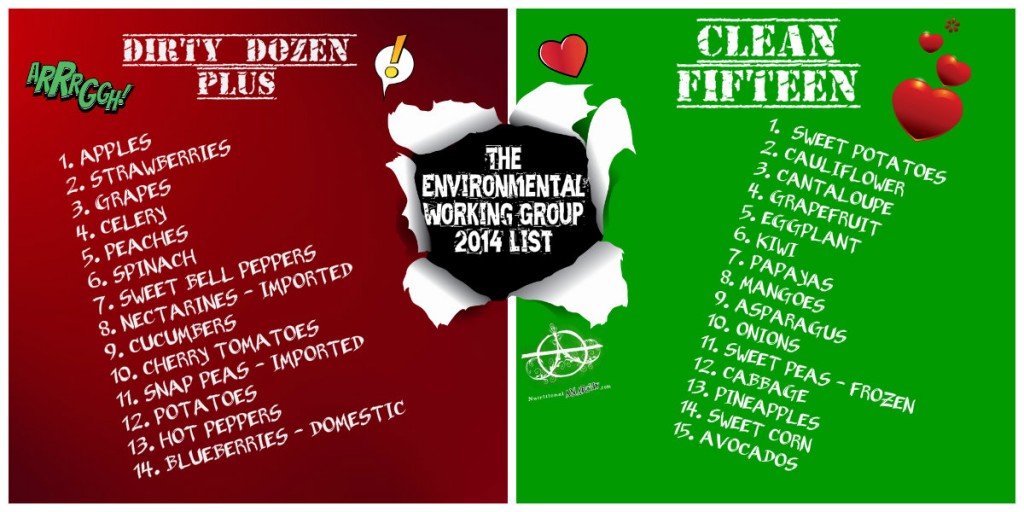If you're new here, you may want to subscribe to my RSS feed. Thanks for visiting!
Originally Published at Nutritional Anarchy
The Environmental Working Group has released its 2014 list of The Dirty Dozen Plus and The Clean Fifteen.
It’s important to note that the suggestions given by EWG are based strictly on the levels of contamination from pesticide. The Clean 15 list does contain items that are potentially genetically modified, so you must be aware of this fact when shopping, as we recommend strict avoidance of all GMOs. For example, field corn and nearly all papayas from Hawaii are genetically modified. Some varieties of sweet corn, tomatoes, mangoes, and zucchini are also genetically modified. This list has absolutely nothing to do with GMOs and everything to do with toxic pesticides. Just because a food is on the list, please understand we are not wholeheartedly endorsing that you go buy the conventional version. Do your research. Remember, if you purchase organic you are not only avoiding pesticides, but also GMOs. You can also look for items verified by the Non-GMO Project.
By purchasing your produce locally as much as possible, you can learn more about the source of your fruits and vegetables, and whether or not they were from GMO seeds. you can find a very comprehensive directory of local farms, co-ops and CSAs across the country HERE.
Anyway, back to pesticides…
The Environmental Protection Agency warns that the ingestion of pesticides can cause health problems such as “birth defects, nerve damage, cancer, and other effects that might occur over a long period of time.” Especially at risk of harm from pesticides are children.
Infants and children may be especially sensitive to health risks posed by pesticides for several reasons:
- their internal organs are still developing and maturing,
- in relation to their body weight, infants and children eat and drink more than adults, possibly increasing their exposure to pesticides in food and water.
- certain behaviors–such as playing on floors or lawns or putting objects in their mouths–increase a child’s exposure to pesticides used in homes and yards.
Pesticides may harm a developing child by blocking the absorption of important food nutrients necessary for normal healthy growth. Another way pesticides may cause harm is if a child’s excretory system is not fully developed, the body may not fully remove pesticides. Also, there are “critical periods” in human development when exposure to a toxin can permanently alter the way an individual’s biological system operates. (source)
The website What’s On My Food takes a stronger stance than the EPA regarding the risks of pesticides.
The human health impacts linked to pesticide exposure range from birth defects and childhood brain cancer in the very young, to Parkinsons’ Disease in the elderly. In between are a variety of other cancers, developmental and neurological disorders, reproductive and hormonal system disruptions, and more.
- Autism
- Breast Cancer
- Children’s diseases
- Endosulfan
- Gestational diabetes
- Parkinson’s Disease
Food Safety News highlighted some of the important findings from the EWG’s report:
- Every sample of imported nectarines tested and 99 percent of apple samples tested positive for at least one pesticide residue.
- The average potato had more pesticides by weight than any other food.
- A single grape tested positive for 15 pesticides. Single samples of celery, cherry tomatoes, imported snap peas and strawberries tested positive for 13 different pesticides apiece.
- Some 89 percent of pineapples, 82 percent of kiwi, 80 percent of papayas, 88 percent of mango and 61 percent of cantaloupe had no residues.
- No single fruit sample from the “Clean Fifteen” list tested positive for more than four types of pesticides. (source)
This year’s format is interesting. The EWG ranked 48 of the top-selling fruits and vegetables from worst to best. The lower the number of the ranking, the more important it is to purchase this item “organic”. For example, in this year’s list, apples are again the absolute worst thing you can buy conventionally grown.
Figuring out what to eat when you’re broke can be fraught with nutritional landmines. It’s expensive to eat strictly organic. Add this excellent tool to your bag of tricks in seeking out the healthiest, most nourishing food available within your budget.
“EWG analyzed pesticide residue testing data from the U.S. Department of Agriculture and Food and Drug Administration to come up with rankings for these popular fresh produce items. All 48 foods are listed below from worst to best
(lower numbers = more pesticides)
Note: EWG analyzed pesticide tests of 48 popular produce items. Domestic and imported versions of three items – nectarines, blueberries and snap peas- showed sharply different results, so we have ranked those domestic and imported items separately. As a result, the full list of foods ranked by the Shopper’s Guide displays 51 entries.” (source)
Drumroll….here is the most important reference you can have when shopping for produce. (Don’t forget to download your full report HERE)
1. APPLES
2. STRAWBERRIES
3. GRAPES
4. CELERY
5. PEACHES
6. SPINACH
7. SWEET BELL PEPPERS
8. NECTARINES – IMPORTED
9. CUCUMBERS
10. CHERRY TOMATOES
11. SNAP PEAS – IMPORTED
12. POTATOES
13. HOT PEPPERS
14. BLUEBERRIES – DOMESTIC
15. LETTUCE
16. KALE / COLLARD GREENS
17. PLUMS
18. CHERRIES
19. NECTARINES – DOMESTIC
20. PEARS
21. TANGERINES
22. CARROTS
23. BLUEBERRIES – IMPORTED
24. GREEN BEANS
25. WINTER SQUASH
26. SUMMER SQUASH
27. RASPBERRIES
28. BROCCOLI
29. SNAP PEAS – DOMESTIC
30. GREEN ONIONS
31. ORANGES
32. BANANAS
33. TOMATOES
34. WATERMELON
35. HONEYDEW MELONS
36. MUSHROOMS
37. SWEET POTATOES
38. CAULIFLOWER
39. CANTALOUPE
40. GRAPEFRUIT
41. EGGPLANT
42. KIWI
43. PAPAYAS
44. MANGOES
45. ASPARAGUS
46. ONIONS
47. SWEET PEAS – FROZEN
48. CABBAGE
49. PINEAPPLES
50. SWEET CORN
51.AVOCADOS















